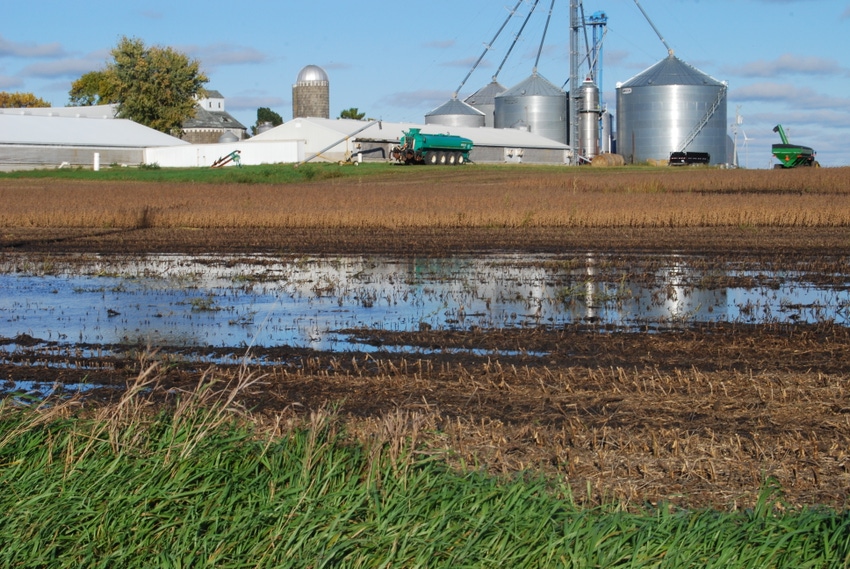
Cool, wet weather kept Iowa farmers mostly out of the fields last week. As a result, they were only able to harvest 2% of the corn and 1% of soybean acres. Corn harvest is now four days behind average, and soybean harvest is running 11 days behind, according to the latest weekly USDA survey.
With just 19% of Iowa’s 2018 soybean crop harvested as of Oct. 14, farmers this year are having the slowest bean harvest on record for Iowa. The weather has been so wet in recent weeks that soybeans in some fields are sprouting in the pods.
Harvest is expected to resume this week, looking at the weather forecast. “With dryer weather in the forecast, farmers will be putting in long hours to bring in the crop as quickly as possible when conditions allow,” notes Iowa Secretary of Agriculture Mike Naig. “We encourage everyone working on the farm or traveling on rural roads to remember to take the time needed to be safe during what can be a very busy and stressful time.”
Iowa farmers have only 17% of the state’s 2018 corn crop harvested vs. 24% for the five-year average at this time. Nebraska farmers have 25% of their corn out of the field, equal to their five-year average.
Corn-producing states in the eastern Corn Belt are way ahead of the western Corn Belt. Illinois has 71% of its corn harvested vs. a 54% five-year average; Indiana has 51% harvested vs. a 39% five-year average. The national corn harvest is 39% complete as of Oct. 14, says USDA, slightly ahead of the five-year average of 35%.
The complete weekly Iowa Crop Progress and Weather Report is at iowaagriculture.gov and nass.usda.gov/ia.
Crop report
Rain and early snow showers limited Iowa farmers to just 0.8 day suitable for fieldwork during the week ending Oct. 14, according to USDA’s National Ag Statistics Service. Activities for the week included moving grain, monitoring field conditions and harvesting corn when weather permitted.
Topsoil moisture levels rated zero percent very short, zero percent short, 40% adequate and 60% surplus. Subsoil moisture levels rated 1% very short, 2% short, 49% adequate and 48% surplus.
Statewide, 97% of the 2018 Iowa corn crop has reached maturity mature, five days ahead of the five-year average. Of the state’s corn for grain crop, 17% has been harvested as of Oct. 14, which is four days ahead of last year but four days behind average.
Across the Iowa farmers were only able to harvest 2% of their corn for grain crop last week. Farmers in southeast Iowa continue to lead the way with 41% of their corn harvested. Moisture content of field corn being harvested in Iowa is at 20%. Corn condition is rated 69% good-to-excellent.
Iowa’s soybean crop is 97% dropping leaves, five days ahead of average. And 19% of the soybean crop has been harvested, 11 days behind the average. This is the smallest percentage of the soybean crop harvested by Oct. 14 since records began. Soybean condition is rated 65% good-to-excellent.
Pasture conditions are 55% good-to-excellent for the statewide average. Livestock conditions remain challenging after another week with significant rainfall leaving feedlots extremely muddy.
Weather summary
According to Justin Glisan, IDALS climatologist, October’s second week brought up to 4 inches of above-average precipitation to Iowa. Average temperatures were predominately cooler than expected; northwest Iowa was 6 to 10 degrees below normal. Parts of western Iowa were near normal to warmer than average for the week ending Oct. 14.
The beginning of the week was active with widespread showers and thunderstorms across Iowa on Monday, Oct. 8, as low pressure moved across the state. Knoxville in Marion County reported a 24-hour accumulation of 4.25 inches. Over 40 stations reported rainfall above 1 inch.
A strong cold front moved through Iowa on Tuesday, Oct. 9, with locally heavy rain. Average highs ranged from the upper 40s in the northwest to the upper 70s in the southeast. Over the two-day period, severe thunderstorms produced 10 confirmed tornadoes, the strongest of which occurred Tuesday evening near Creston in Union County, with estimated winds up to 120 mph, causing structural damage.
The cold front moved out of eastern Iowa early Wednesday, Oct. 10, leaving behind cloudy and unseasonably cool temperatures. Average highs varied from the 50s in the west and 60s to lower 70s ahead of the cold front. Dubuque in Dubuque County reported 0.99 inch of rain.
Light rain showers moved in on Friday, Oct. 12. Some locations in central Iowa reported snowflakes. Saturday, Oct. 13, was relatively dry with spotty showers late in the day in northwest Iowa. Sunday, Oct. 14, saw a mix of rain and snow with light accumulations on grass and elevated surfaces, especially in north-central Iowa.
Weekend temperatures were below normal with highs in the upper 40s and lower 50s. Davenport in Scott County had the week’s high of 84 degrees on Monday, 18 degrees above normal. The week’s lowest temperature of 24 degrees was reported in Sanborn and Sheldon in O’Brien County on Oct. 14, an average of 12 degrees below normal.
About the Author(s)
You May Also Like




